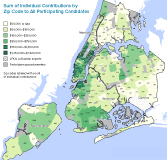By the People: The New York City Campaign Finance Program in the 2013 Elections
Report Shows Campaigns Relied on Small Contributions Public Funds Reduced the Impact of Big Money and Special Interests
Candidates for City office in last year’s elections overwhelmingly funded their campaigns with small contributions from City residents according to a comprehensive report released today by the New York City Campaign Finance Board (CFB). The report, “By the People: The New York City Campaign Finance Program in the 2013 Elections,” also includes the Board’s recommendations for legislative actions to strengthen and improve the administration of the Program. (Download the report).
The report shows how New York City’s landmark small-dollar public matching funds program helps candidates rely on New York City residents to fund their campaigns. Small-dollar contributors live in every neighborhood throughout the city, and the matching funds that amplify their impact allowed candidates to fund their campaigns without relying on large, potentially corrupting contributions from institutional supporters and special interests.
- More than two-thirds of the total amount of individual contributions collected by participating candidates came from residents of New York City.
- More than two-thirds of all New York City contributors gave $175 or less.
- More than 90 percent of the total raised came from individual contributors, not PACs or unions.
For this report, the CFB worked with the Center for Urban Research at the CUNY Graduate Center to prepare maps showing contribution patterns within New York City.
The partnership resulted in maps appearing in the printed report and interactive maps that allow the viewer to explore where in the city candidates for different offices raised contributions.
The appendices contain reports and disclosure data used in the post-election report and in the maps.
Candidate participation in the Program has remained extremely high, indicating most candidates feel that matching funds provide an effective way to fund their campaign.
- The general election for mayor featured Program participants from both major parties for the first time since 1997. The CFB paid $14 million to mayoral candidates, the most in Program history.
- The 2013 elections were the most competitive since 2001. In the Democratic primary for City Council, 38 of 51 districts had contested or competitive races. (Just 30 percent of state Assembly and Senate districts in New York City will have a contested Democratic primary on September 9.)
- Two Program candidates for citywide office defeated high-spending, self-funded candidates in the primary elections (Republican mayoral, Democratic comptroller).
Outside spending played a large role, but several participating candidates won elections despite being opposed by significant independent expenditures. The matching funds helped ensure that voters, not money, decided last year’s elections. The CFB’s disclosure rules provided New York City voters with detailed information about outside spenders and their activities.
- Outside groups spent an astonishing $15.9 million to influence the outcome of the 2013 elections, including $6.2 million spent on the City Council primary elections alone.
- New York City’s strong disclosure rules helped ensure that New Yorkers could see where those groups raised their funds, and how they spent their money. The “dark money” spending often seen in federal and state elections did not happen under the City’s rules.







